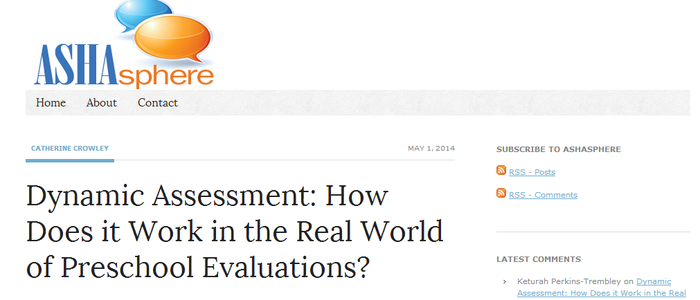 In a disability evaluation, we ask a child to point “to the triangle” or “to the author” as part of test developed to identify disorder. An evaluator who uses this kind of test to identify disability must assume that all children being evaluated have had similar exposure to “triangle” and “author” including similar family, cultural, and educational experiences. It follows then, that if a child cannot identify “triangle” or “author” it is because that child has some kind of learning problem. But what if a child does not have a disability but simply did not have the same exposure to “triangle” or books as the majority of children his age? Dynamic assessment offers evaluators an approach to see whether a child can acquire new linguistic information from the environment. Here are some clinicians examples of how to translate the dynamic assessment research into their own disability evaluations, including some “dynamic” approaches to increase the accuracy of our preschool disability evaluations.
In a disability evaluation, we ask a child to point “to the triangle” or “to the author” as part of test developed to identify disorder. An evaluator who uses this kind of test to identify disability must assume that all children being evaluated have had similar exposure to “triangle” and “author” including similar family, cultural, and educational experiences. It follows then, that if a child cannot identify “triangle” or “author” it is because that child has some kind of learning problem. But what if a child does not have a disability but simply did not have the same exposure to “triangle” or books as the majority of children his age? Dynamic assessment offers evaluators an approach to see whether a child can acquire new linguistic information from the environment. Here are some clinicians examples of how to translate the dynamic assessment research into their own disability evaluations, including some “dynamic” approaches to increase the accuracy of our preschool disability evaluations.
First, Let us consider nonword repetition tasks, one type of dynamic assessment. Nonword repetition tasks assess whether a child can hear, retain briefly, and then repeat nonsense syllables of varying lengths. Nonword repetition tasks give us insight into why a child may have a weak vocabulary. If the child has difficulty with nonword repetition tasks it may indicate a disordered ability to learn new words from the environment and will also affect the child’s ability to understand directors and spoken stories. Here are two modules analyzing videos of several children, both with and without language impairments, doing the same nonword repetition task. By seeing how different children of different abilities perform as they acquire the new words, clinicians acquire clinical judgment. Nonword repetition tasks are not classic dynamic assessment because there is no pre and post-test. But because we watch the child learning new syllables in front of us, it is dynamic rather than static.
Another dynamic approach is fast word mapping. In fast word mapping we evaluate whether a child can learn new words. Because the words are completely made up, no child has more or less experience with these words. In these videos of 4-year-olds, one child is typically developing, one child has low average to mildly delayed skills, and one child has mild to moderate delays. What is especially helpful with more dynamic approaches to assessment, we see a much greater range of information about a child’s skills, rather than simply did he identify the “triangle” or not?
A child’s cognitive skills, including the ability of children to describe cognitively challenging tasks, can also be seen through dynamic assessment. Here is an example of how a psychologist used dynamic assessment to evaluate the nonverbal cognitive skills of a 2 year 10 month old boy with Autism Spectrum Disorder (See 8:25 to 10:50). The psychologist described in his report what he saw as:“Dynamic assessment demonstrated that George is intelligent and learns quickly. The evaluator showed George how to make a rubber duck fly into the air by placing the duck on the flat end of a spoon placed on the table and hitting the round end. George smiled and laughed and searched for the duck, although he did not make eye contact with the evaluator. George tried and had difficulty the first time, but after a second demonstration George was able to make the duck fly and seemed happy he made it happen.”
David’s dynamic assessment task reminds me of one that a great trilingual SLP, Barbara Dittman, showed me. She used the disappearing egg in the cup trick.Barbara would show the trick to the student and tell him how to do it. Then she would bring another person–a parent, teacher, or peer—and have the student do the trick and then explain to the person how to do it. Barbara learned about cognition and also about the student’s ability to explain a somewhat challenging task.
Recent articles demonstrate similar effectiveness of dynamic assessment in distinguishing bilingual preschoolers with and without disabilities. These dynamic assessment tasks for bilingual preschoolers include fast word mapping and agraduated prompting task with a novel word learning, semantic, and phonological awareness component.
Based on research going back several decades, the importance of dynamic assessment in accurate identifying a language disorder is well established. New studies continue to support its value. In addition to the videos on dynamic assessment and preschool assessment in general, the LEADERSproject.org has many resources available to anyone looking to sharpen their disability evaluation skills including test reviews, discussion of current law, regulations, and policies, andmodel evaluations.
See this post on ASHA.

![[feed link]](/wp-content/plugins/rss-just-better/rss-cube.gif)